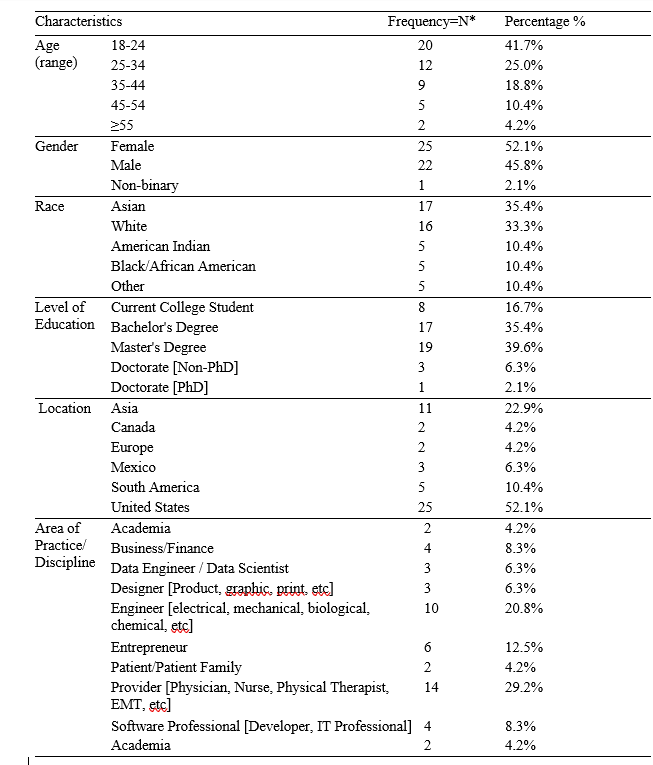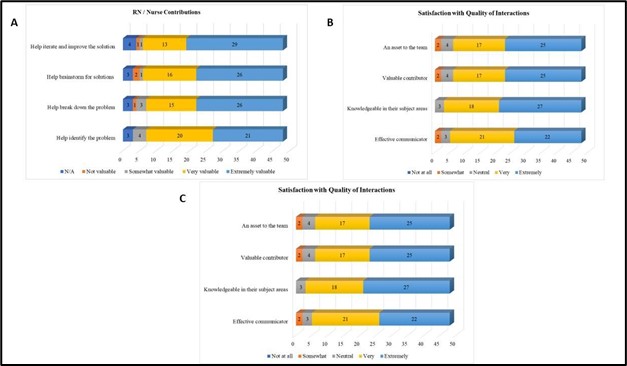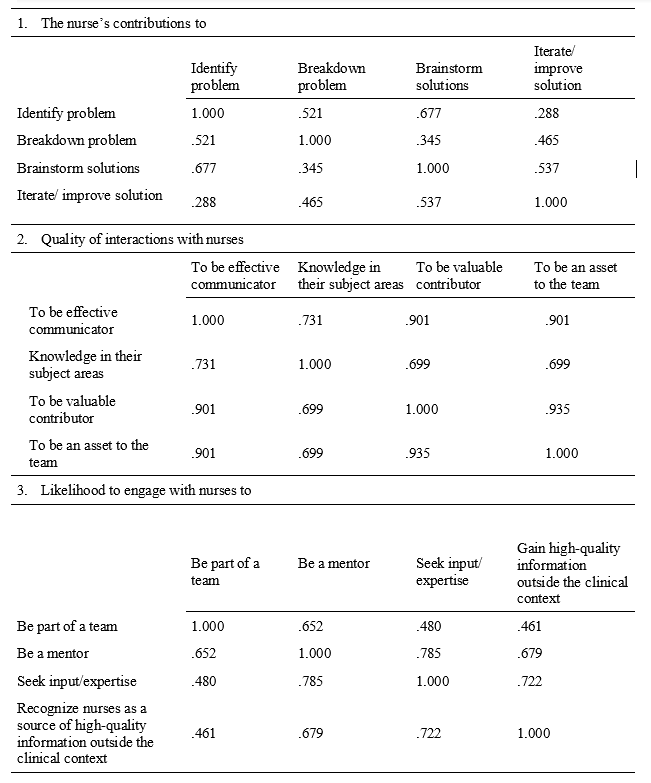Nurse’s Contributions to Collaborative Problem Solving, Entrepreneurship and Innovation at virtual MIT Hackathons During the Covid-19 Pandemic
by Kelly Ayala, DNP, APNP, BSN
*Olga Kagan, PhD, RN
Molloy University / CUNY SPS
Joshua Littlejohn, MPH, MSN, RN
Rebecca Koszalinski, PhD, MS, BSN, RN, CRRN,
Associate Professor
Christine E. Lynn College of Nursing
Florida Atlantic University
Hiyam Nadel, MBA, RN, CCG
Director, Center of Innovations in Care Delivery
Massachusetts General Hospital

Citation: Ayala, K., Kagan, O., Littlejohn, J., Koszalinski, R. & Nadel, H. (2022). Nurse’s Contributions to Collaborative Problem Solving, Entrepreneurship and Innovation at virtual MIT Hackathons During the Covid-19 Pandemic. Canadian Journal of Nursing Informatics, 17(3-4). https://cjni.net/journal/?p=10468
Abstract
Background: The COVID-19 pandemic propelled the use of online collaborative platforms to bring diverse individuals together to drive rapid innovation in healthcare. Massachusetts Institute of Technology (MIT) Hacking Medicine hackathons served as an ideal space for collaborative problem-solving, entrepreneurship, and innovation. We aimed to assess the impact of nurses within MIT-led hackathons, which may provide insight into the value nurses bring to other challenges in healthcare.
Methods: An anonymous 25-item Google forms survey was disseminated to the MIT COVID-19 Challenge participants through the SLACK online platform for six MIT-led hackathons in 2020.
Results: Out of 65 responses, 48 met the inclusion criteria. Nurses’ contributions were considered “very” or “extremely” valuable in helping to identify and break down the problem (85%), and in helping to brainstorm and iterate the solution (88%). The participants were “very” and “extremely” satisfied with the nurses’ abilities to be an asset to the team and valuable contributors (88%), knowledgeable (94%), and effective communicators (90%). They recognized the nurses as a source of high-quality information outside the clinical context (92%), indicated an interest in seeking expertise from nurses (90%), seek nurses as a mentor (83%) and as team members (79%).
Conclusions: Nurses can make important contributions to teams working on innovative healthcare solutions across the globe via online platforms. Involving them in problem-solving teams should be encouraged.
Keywords
MIT hackathons, online platforms, nurse contributions, healthcare innovation, collaborative problem solving, COVID-19 pandemic.
Background
The COVID-19 global pandemic highlighted gaps in healthcare delivery, especially in socio-economic segments and geographic areas, stimulating worldwide collaboration and innovation. The hackathon solution—where groups of people with diverse backgrounds meet to solve problems in a compressed time frame, generally a weekend— is ideal for meeting this kind of challenge. Hackathons rapidly identify problems, ideate together, and create low-cost, inventive solutions.
Nurses make up one of the largest segments of the healthcare workforce, (American Association of Colleges of Nursing (AACN), 2019; National Council of State Boards of Nursing (NCSBN), 2020), and are intimately involved with every aspect of patient care, offering a bird’s eye view of healthcare’s most difficult problems. During the pandemic, leaders within the healthcare industry turned to nurse leaders for guidance (Butler, 2020; Kagan & Connor, 2022; HIMSS New York State, 2020). The pandemic presented an opportunity to bring nurses together across the globe to solve major health challenges.
Nurses have been present at multiple hackathons in recent years; some with a specific nursing focus and others as contributors (Kagan et al., 2021). As trusted experts and bedside caregivers, nurses make ideal hackathon participants. The requirement for virtual meetings during the pandemic increased the opportunity to participate in hackathons.
The Massachusetts Institute of Technology (MIT) Hacking Medicine held multiple hackathons in 2020 focused on challenges such as the pandemic and solving racism in healthcare. Nurses had the opportunity to engage with engineers, scientists, and software developers by joining teams in various capacities as participants, team mentors, team leaders, and judges. Our goal was to assess nurses’ impact within these hackathons and to provide insight into the value nurses bring to teams in solving challenges in healthcare.
Methods
An anonymous 25-item Google forms survey (Koszalinski et al., 2021) was electronically distributed to participating hackers (scientists, designers, engineers, and others) 18 or older who engaged with nurses for any length of time in six MIT- led hackathons via the general announcement channel on the Slack platform. The questions on the survey were related to the iteration process which 1) identifies the problem, 2) breaks the problem down into a clear understanding of the root cause, 3) brainstorms for solutions, and 4) iterates and improves. This iterative process is followed until a solution is achieved.
Screening questions determined participation eligibility by establishing age and confirmation of having interactions with a nurse. Six demographic questions collected de-identified data about the participant’s gender, education, discipline, region, and race/ethnicity. Participants were also asked to check all that apply to the nurse’s role with the team, such as mentor, pitch mentor, judge, team member, or team leader. Likert-type questions were designed: four questions assessed nurses’ contributions to the four areas of the hackathon process framework, four questions assessed the quality of interactions, and four questions assessed the likelihood to engage with a nurse in the future. One question solicited three descriptors from the participant’s view of the nurses. The final question asked the disposition of the team (winner/non-winner in category). Participants had an opportunity to include additional comments in text format. The survey tool was analyzed for internal consistency using Cronbach’s alpha and reliability using inter-item correlation.
Results
Out of 65 total participant responses for all six events, 48 participants met the inclusion criteria. Five respondents from India Turning the Tide, 19 from Hacking Racism in Healthcare, five from Grand Hack, and six from Hack4TheFuture. Included are 8 responses from MIT COVID-19 Challenge Beat the Pandemic II and five responses from Latin America vs. COVID-19 that were previously reported (Koszalinski et al, 2021).
Respondents had diverse backgrounds. The majority (67%) were between ages 18 and 34 and held a master’s degree (40%) or bachelor’s degree (35%). Nurses were identified as team mentors (35%), team members (33%), pitch mentors/coaches (15%), final pitch judges (6%), and team leaders (2%). Table 1 contains additional details.
Table 1: Demographic Data
The majority of the respondents were non-healthcare professionals (71%). The role of the nurse’s contributions, quality of interactions, and likelihood to engage with a nurse in the future is described in Figure 1. Nurses’ contributions were considered “very” or “extremely” valuable in helping to identify the problem (85%), break down the problem (85%), brainstorm for solutions (88%), iterate and improve the solution (88%), (Figure 1A). The participants were “very” and “extremely” satisfied with the nurses’ abilities to be both an asset to the team and a valuable contributor (88%); knowledgeable (94%), and an effective communicator (90%) (Figure 1B). Participants’ responses indicated their experience/interaction with nurses’ as positive and indicated they were “very” or “extremely” likely to recognize nurses as a source of high-quality information outside the clinical context (92%), to seek input/expertise from a nurse (90%), to request a nurse as a mentor (83%)and to have nurses as a team member (79%). (Figure 1C).
Figure 1: Survey items
The survey tool reliability demonstrated a Cronbach’s alpha of 0.78 for the 4-item value of the RN contributions sub-scale, 0.94 for the 4-item satisfaction with RN contributions sub-scale, and 0.86 for the 5-item likelihood for future engagement of nurses’ sub-scale (Table 2). Inter-item correlation is described in Table 3. These results support the use of our measures.
Table 2: Psychometric properties for three scales
Table 3: Inter-Item Correlation Matrix for Three Scales
Additionally, respondents provided three words they believed described nurses (Figure 2).
Figure 2. Descriptors of nurses by the survey respondents.
Verbatim comments captured the intent of the collaborative events with the following examples:
“[Mentor’s] inputs were really valuable and helped us take our pitch to the next level.
I am an engineer/designer and those interactions… encouraged me to continue towards the path I initialized recently of becoming a nurse.”
“I believe the nurse on our team led us to victory! Nurses are innovators and deserve recognition.”
Discussion
The increased involvement of nurses in hackathons beginning in 2019 created the opportunity for nurses to attend, influence, and lead the larger and well-known hackathons sponsored by MIT the following year. Hackathons provide nurses with an opportunity to collaborate with stakeholders from other industries in developing healthcare solutions. By working with interdisciplinary teams, nurses can leverage their skills, knowledge, and experience. Non-healthcare participants welcomed nurses as part of their teams and as mentors, identified their contributions as valuable, and found nurses to be both knowledgeable and good communicators. They looked forward to engaging with nurses in future innovation spaces. Health leaders may want to ensure that nurses are included in interdisciplinary teams to solve healthcare challenges locally and globally.
Prior to 2019, nurses were mostly absent from collaborative innovation (Kagan et al., 2021). In the United States, only one article (Chen et al., 2020) specifically mentioned the involvement of a Nurse Practitioner student. In other healthcare hackathons nurses’ participation, if any, was not documented. Similarly, minimal information was given about nurses’ participation in Israel (Ramadi et al., 2019) and Thailand (Pathanasethpong et al., 2020). In Pakistan nurses and nursing students described the use of hackathons (Baig et al., 2021; Butt et al., 2021; Farooqi et al 2017) and the importance of involving all the stakeholders, including patients, nurses, and members of other professions was noted.
MIT Hacking Medicine (MIT Hacking Medicine, n.d.), is known for the inclusion of various categories of healthcare professionals and other disciplines. In 2020, nurses were invited as participants, mentors, coaches, organizers, and judges. As invitees we wished to provide insight into nurses’ impact during six MIT-led hackathons with the goal of informing others about the value nurses can bring to teams.
We demonstrated the importance of nurses’ contributions to innovation and entrepreneurship during these events, wherein the majority of participants were non-healthcare professionals. Nurses’ expertise was well-received and valued. Looking toward the future, seeking nurses’ expertise, and inviting them to teams to solve problems in healthcare should be strongly encouraged. Capitalizing on the use of currently available online platforms, more nurses are encouraged to pursue these event opportunities to collaborate with and contribute to healthcare innovation worldwide.
References
American Association of Colleges of Nursing (2019). Nursing Fact Sheet. AACN. https://www.aacnnursing.org/News-Information/Fact-Sheets/Nursing-Fact-Sheet
Butler, S. (2020) Big data & AI meet precision nursing. Audio blog. Johnson & Johnson Nursing. https://nursing.jnj.com/see-you-now-podcast/35-big-data-ai-meet-precision-nursing
Baig, M. N. A., Farooqi, W.H. & Mian, A. (2021) Innovation in emergency medicine; a perspective from a low middle-income country, Pakistan. Special Report. JPMA. The Journal of the Pakistan Medical Association, 71(2-B): 734–736. DOI : 10.47391/JPMA.1272.
Butt, W. A., Shariff, A., Khan, S., & Mian, A. I. (2021). Global Surgery Hackathons: A Case Study from Pakistan. Surgical innovation, 28(4), 496–501. https://doi.org/10.1177/15533506211018619
Chen, K., Kruger, J., McCarther, N., & Meah, Y. (2020). Interprofessional, learner-driven collaboration for innovative solutions to healthcare delivery in student-run clinics. Journal of interprofessional care, 34(1), 137–139. https://doi.org/10.1080/13561820.2019.1635094
Cooper, K., Siefert, A., & Weinreb, J. (2018). Skills Beyond the Reading Room: Training in Innovation and Collaboration at a Radiology Hackathon. Journal of the American College of Radiology: JACR, 15(3 Pt A), 466–468. https://doi.org/10.1016/j.jacr.2017.10.025
Farooqi, W., Subhani, F., & Mian, A. (2017). Paediatric innovation in Pakistan: our experience and a call to action. Archives of disease in childhood, 102(10), 963–967. https://doi.org/10.1136/archdischild-2016-312123
HIMSS New York State. (2020). 2020 Nursing Innovations: Stories from the Front Line. [YouTube Video] https://youtu.be/JzniM6Vv-rM
Kagan, O. & Connor, M. (2022). Paving the way: HIMSS NYS chapter Spring 2022 virtual nursing symposium. Guest Editorial. Online Journal of Nursing Informatics (OJNI), 26(2). https://www.himss.org/resources/online-journal-nursing-informatics
Kagan, O., Littlejohn, J., Nadel, H., Leary, M., (September 30, 2021) Evolution of Nurse-Led Hackathons, Incubators, and Accelerators from an Innovation Ecosystem Perspective OJIN: The Online Journal of Issues in Nursing, 26(3), Manuscript 3. https://doi.org/10.3912/OJIN.Vol26No03Man03
Koszalinski, R. S., Kagan, O., Littlejohn, J., & Nadel, H. (2021). Collaborative COVID-19 problem-solving: Nurses as content experts, mentors, and judges. OJIN: The Online Journal of Issues in Nursing, 26(3). https://doi.org/10.3912/OJIN.Vol26No03PPT39
McLeod, P. L., Cunningham, Q. W., DiazGranados, D., Dodoiu, G., Kaplan, S., Keyton, J., Larson, N., LeNoble, C., Marsch, S. U., O’Neill, T. A., Parker, S. H., Semmer, N. K., Shuffler, M., Su, L., Tschan, F., Waller, M., & Wang, Y. (2021). Hacking teamwork in health care: Addressing adverse effects of ad hoc team composition in critical care medicine. Health care management review, 46(4), 341–348. https://doi.org/10.1097/HMR.0000000000000265
MIT Hacking Medicine (n.d.) MIT Hacking Medicine. https://hackingmedicine.mit.edu/about/
National Council of State Boards of Nursing. (2020). NCSBN’s environmental scan a portrait of nursing and healthcare in 2020 and beyond. Journal of Nursing Regulation 10(4, Supplement 1): S1–S35. DOI: https://doi.org/10.1016/S2155-8256(20)30022-3
Pathanasethpong, A., Areemit, R., Teerakulpisut, D., Morley, K., & Morley, M. (2020). Health hackathon as a venue for interprofessional education: a qualitative interview study. Journal of interprofessional care, 34(6), 832–834. https://doi.org/10.1080/13561820.2019.1696760
Ramadi, K., Srinavasan, S., & Atun, R. (2019). Health diplomacy through health entrepreneurship: using hackathons to address Palestinian-Israeli health concerns. BMJ Global Health, 4(4), e001548. https://doi.org/10.1136/bmjgh-2019-001548
*Corresponding author
Olga Kagan okagan@molloy.edu; (516) 457-4763
Acknowledgment: The authors would like to acknowledge Freddy Nguyen, MD, Ph.D. Research Fellow at MIT for assisting with data acquisition, Marion Leary, MSN, MPH, RN, and Allan S Nadel, MD for editing this manuscript.
Funding: This research did not receive any support, financially or in kind.
Conflict of Interest: Authors are members of SONSIEL (Society of Nurse Scientists, Innovators, Entrepreneurs and Leaders).











